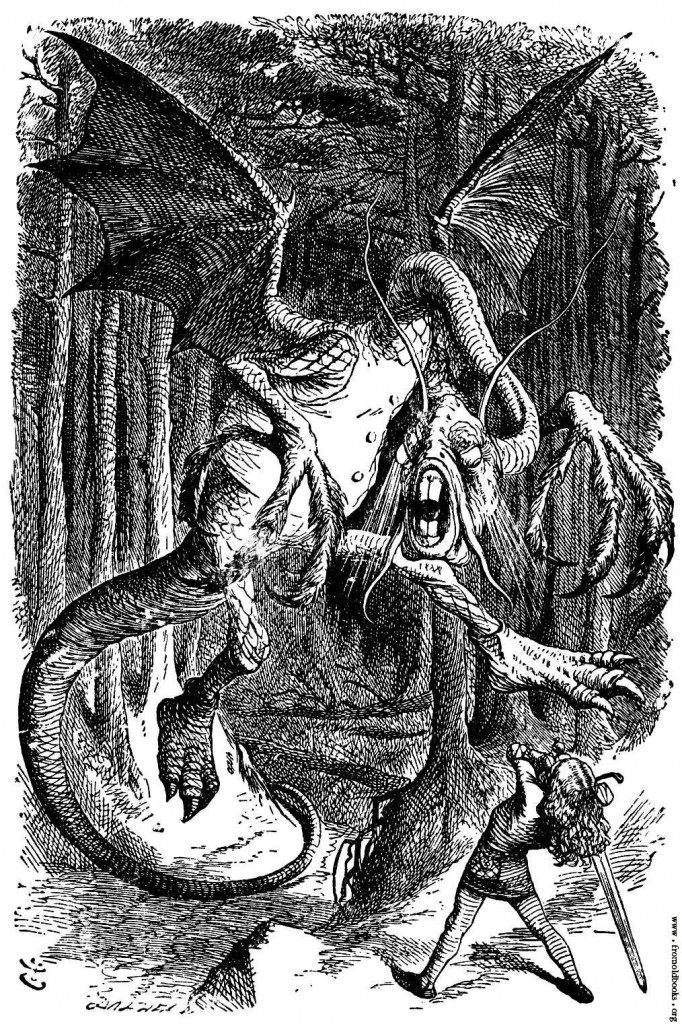Jabberwocky by Lewis Carroll
- Comments Off on Jabberwocky by Lewis Carroll
- By Sanguis Draconem

The question of whether or not the Jabberwocky (from Lewis Carroll’s Through the Looking-Glass and What Alice Found There) is a dragon is debatable for some, while inspiring a resounding no in others. But what is a dragon in its mythological form? Does it need to possess universal physical attributes, or is it defined by its role within the story? Considering each culture has interpreted the physical nature of dragons in various ways, it’s important to recognize not only what the dragon physically appears to be, but what the dragon does and why it does it; its symbolic significance.
In Lewis Carroll’s poem, the Jabberwocky is a truly fearsome opponent; a nightmarish creature who bites and claws and possesses “eyes of flame”.
Flame, or fire, is a very important element to note.
Fire is a substance of pure duality; it’s destructive, potentially uncontrollable and chaotic; when fire goes unchecked, it leaves nothing but ruin in its wake. But at the other end of the spectrum, fire is life.
Mythology tells us, at great personal risk and sacrifice, the Titan Prometheus stole fire from the gods for the benefit of mankind.
Fire literally enables human beings to withstand the cold and see in the darkness; harnessing it is a hallmark of civilization, and a symbol of knowledge and enlightenment. And when people talk about the eternal flame of the soul, or a fire that describes passionate love, it symbolizes those forces people believe can withstand time itself.
In theory, eyes of flame can see with a power that wields both the potential destruction and the potential salvation of mankind; like a dragon protecting its treasure, fiercely guarding a thing which is significantly and terribly valuable.
Regarding the artistic representation of the Jabberwocky, given that Carroll doesn’t paint in all the details for the reader, various artists and filmmakers have interpreted this creature to have typical dragon-like tendencies. Large wings and serpentine characteristics are common, some even endowing it with the ability to breathe fire. When imagination has filled in the gaps, drawing from the preexisting dragon lore seems to have been a natural choice.
Therefore, within the collective consciousness, through its various well-known manifestations and symbolic interpretations, the Jabberwocky has become a dragon, regardless of whether or not it initially ever was.
`Twas brillig, and the slithy toves
Did gyre and gimble in the wabe:
All mimsy were the borogoves,
And the mome raths outgrabe.
“Beware the Jabberwock, my son!
The jaws that bite, the claws that catch!
Beware the Jubjub bird, and shun
The frumious Bandersnatch!”
He took his vorpal sword in hand:
Long time the manxome foe he sought —
So rested he by the Tumtum tree,
And stood awhile in thought.
And, as in uffish thought he stood,
The Jabberwock, with eyes of flame,
Came whiffling through the tulgey wood,
And burbled as it came!
One, two! One, two! And through and through
The vorpal blade went snicker-snack!
He left it dead, and with its head
He went galumphing back.
“And, has thou slain the Jabberwock?
Come to my arms, my beamish boy!
O frabjous day! Callooh! Callay!’
He chortled in his joy.
`Twas brillig, and the slithy toves
Did gyre and gimble in the wabe;
All mimsy were the borogoves,
And the mome raths outgrabe.
Comments